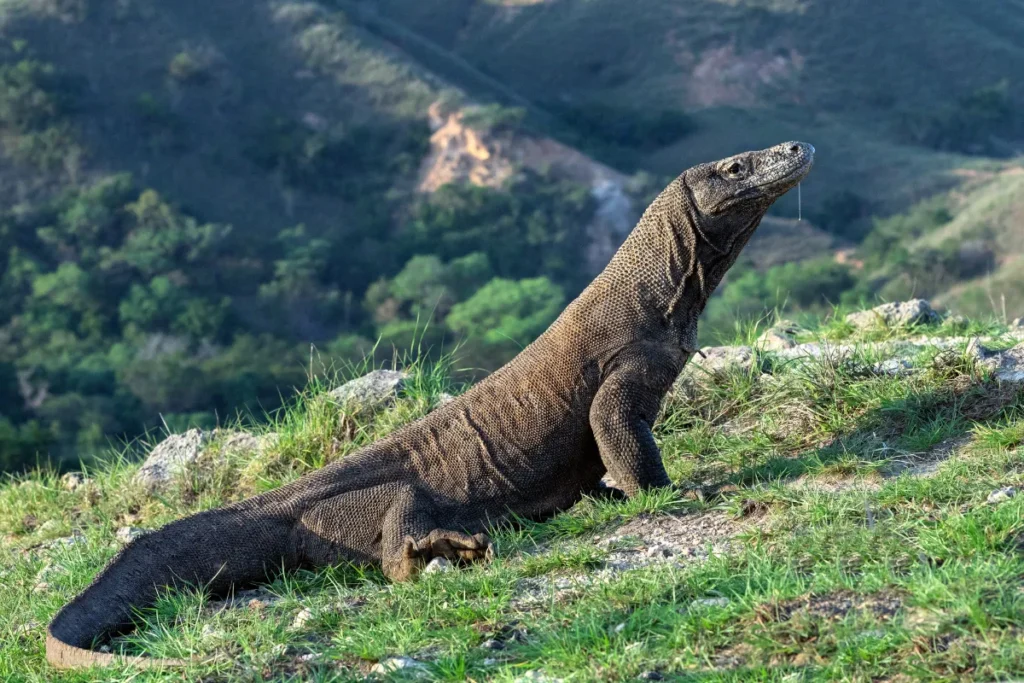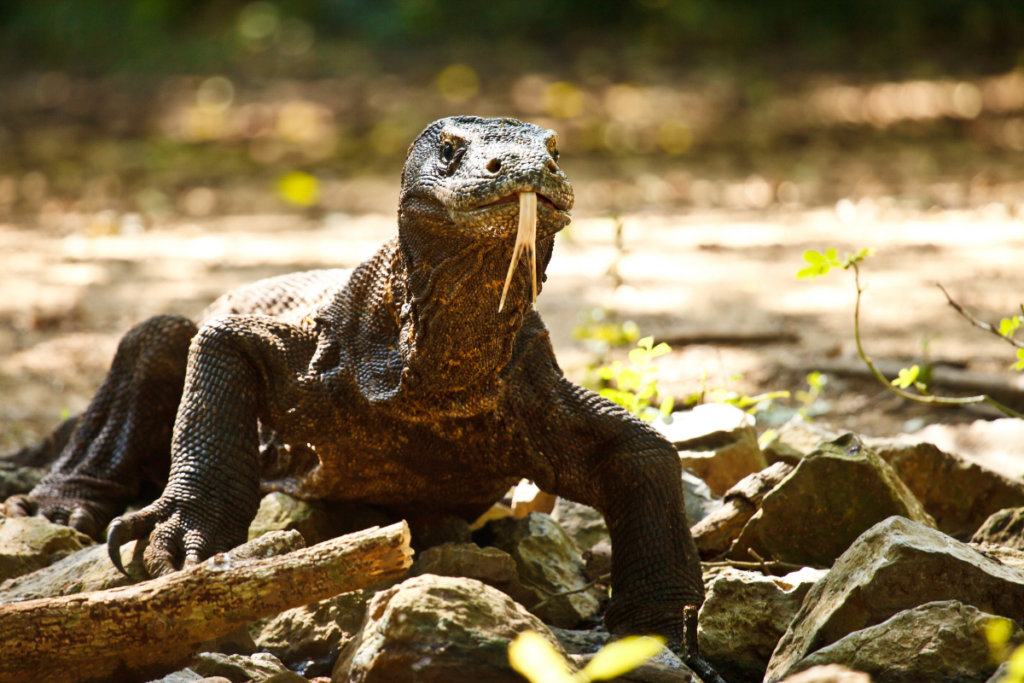Komodo dragons (Varanus komodoensis) stand as magnificent giants in the world of reptiles, occupying a unique ecological niche on the Indonesian islands of Komodo, Rinca, Flores, and Gili Motang.
These formidable creatures are not only the largest living lizards but also among the most intriguing, with a biology shaped by millions of years of evolution and a behavior that reflects their role as apex predators in their habitat.
In this article, we delve into the intricate details of Komodo dragons, exploring their biology, behavior, and ecological significance, while also examining the conservation challenges they face in the modern era.
I. Introduction

Nestled within the tropical savannahs and forests of Indonesia, the Komodo dragon captivates with its size, strength, and ancient lineage.
As we unravel the complexities of its biology, behavior, and ecological interactions, a deeper understanding emerges of how these creatures have adapted and thrived in their island habitat.
II. Biology of Komodo Dragons
A. Physical Characteristics

Komodo dragons are renowned for their impressive size and robust build, making them the largest lizards in existence.
Adult males can reach lengths of up to 3 meters (10 feet) and weigh over 70 kilograms (150 pounds).
Their powerful limbs, equipped with sharp claws, enable them to navigate diverse terrain, from rocky outcrops to dense forests.
Their scaly skin, often colored in shades of gray, brown, or green, provides protection against abrasions and injuries.
B. Sensory Adaptations
Vision and Hearing: Komodo dragons possess keen eyesight that allows them to detect movement over long distances.
Their auditory senses are also finely tuned, enabling them to perceive subtle sounds, which aids in both hunting and communication.
Olfactory System: Their forked tongues and specialized Jacobson’s organ play a crucial role in scent detection.
By flicking their tongues and sampling the air, Komodo dragons can locate prey, detect potential mates, and navigate their environment effectively.
C. Reproductive Biology
Komodo dragons exhibit a slow rate of growth and sexual maturity, with males typically reaching maturity around 8-9 years of age, while females mature at around 5-7 years. Mating typically occurs between May and August, with females laying their eggs in September.
Nesting sites are carefully selected in sandy soil to provide optimal conditions for incubation, with hatchlings emerging from their eggs after approximately 7-8 months.
III. Behavior of Komodo Dragons

A. Hunting and Feeding Behavior
Predatory Techniques: Komodo dragons are opportunistic apex predators, hunting a wide range of prey including deer, wild boar, and smaller mammals.
They employ a combination of stealth and ambush tactics, lying in wait for unsuspecting prey before launching a sudden attack.
Venomous Bite: Unlike other reptiles, Komodo dragons possess venom glands in their lower jaw that inject a potent cocktail of toxins into their prey.
This venom contains anticoagulants that prevent blood clotting, causing prey to weaken and eventually succumb to the dragon’s attack.
Scavenging: In addition to hunting, Komodo dragons are proficient scavengers, consuming carrion when available.
Their ability to detect and consume decaying matter further underscores their role as key contributors to nutrient cycling within their ecosystem.
B. Social Structure and Communication
Komodo dragons exhibit solitary behaviors for much of their lives, with adults typically interacting only during mating or territorial disputes.
Communication among individuals primarily involves visual displays, vocalizations, and olfactory cues, which are instrumental in establishing dominance and maintaining social hierarchies.
IV. Ecology of Komodo Dragons
A. Habitat and Distribution
Komodo dragons are endemic to several Indonesian islands, including Komodo, Rinca, Flores, and Gili Motang.
They inhabit a range of ecosystems, from dry savannahs to dense forests, where they play a pivotal role as apex predators.
The diverse habitats they occupy contribute to their ability to adapt to varying environmental conditions and resource availability.
B. Ecological Role as Apex Predators
Regulation of Prey Populations: As apex predators, Komodo dragons play a crucial role in regulating the populations of herbivores such as deer and wild boar.
By controlling prey numbers, they help maintain ecological balance and prevent overgrazing that can lead to habitat degradation.
Nutrient Cycling: Komodo dragons contribute to nutrient cycling within their habitat through their feeding behaviors, which include both predation and scavenging.
By consuming carrion and recycling organic matter, they enrich the soil and support the growth of vegetation.
V. Conservation Challenges and Efforts
A. Threats to Survival
Despite their resilience, Komodo dragons face significant conservation challenges, primarily driven by human activities.
Habitat loss due to agriculture, infrastructure development, and climate change poses a threat to their natural habitat, reducing available resources and fragmenting populations.
Additionally, poaching and illegal wildlife trade threaten their existence, driven by demand for their skins and traditional medicinal uses.
B. Conservation Initiatives
Efforts to conserve Komodo dragons are multifaceted, involving habitat protection, community engagement, and legislative measures.
Komodo National Park, established in 1980, serves as a protected area for these iconic lizards, providing a sanctuary where conservationists conduct research, monitor populations, and implement strategies to mitigate human-wildlife conflict.
VI. Future Directions: Ensuring the Survival of Komodo Dragons
A. Research and Monitoring
Continued research is essential to deepen our understanding of Komodo dragon biology, behavior, and ecological interactions.
Advances in genetic studies, habitat monitoring, and population assessments are crucial for informing conservation strategies and adapting management practices in response to environmental changes.
B. Education and Awareness
Raising awareness about the importance of Komodo dragons and their role in maintaining ecosystem health is fundamental to garnering support for conservation efforts.
Education programs aimed at local communities, tourists, and policymakers can foster appreciation for these remarkable creatures and promote sustainable practices that protect their habitat.
VII. Conclusion
Komodo dragons, with their ancient lineage and extraordinary adaptations, exemplify the resilience of wildlife in the face of environmental challenges.
By safeguarding their habitats and implementing effective conservation measures, we can ensure that future generations continue to marvel at these magnificent creatures and appreciate their role in the natural world.
In conclusion, the study of Komodo dragons offers not only insights into their remarkable biology and behavior but also underscores the urgency of conservation efforts to protect these ancient predators and preserve biodiversity on a global scale.
This article provides a comprehensive exploration of Komodo dragons, encompassing their biology, behavior, ecological interactions, conservation challenges, and the critical importance of safeguarding their future in our changing world.




